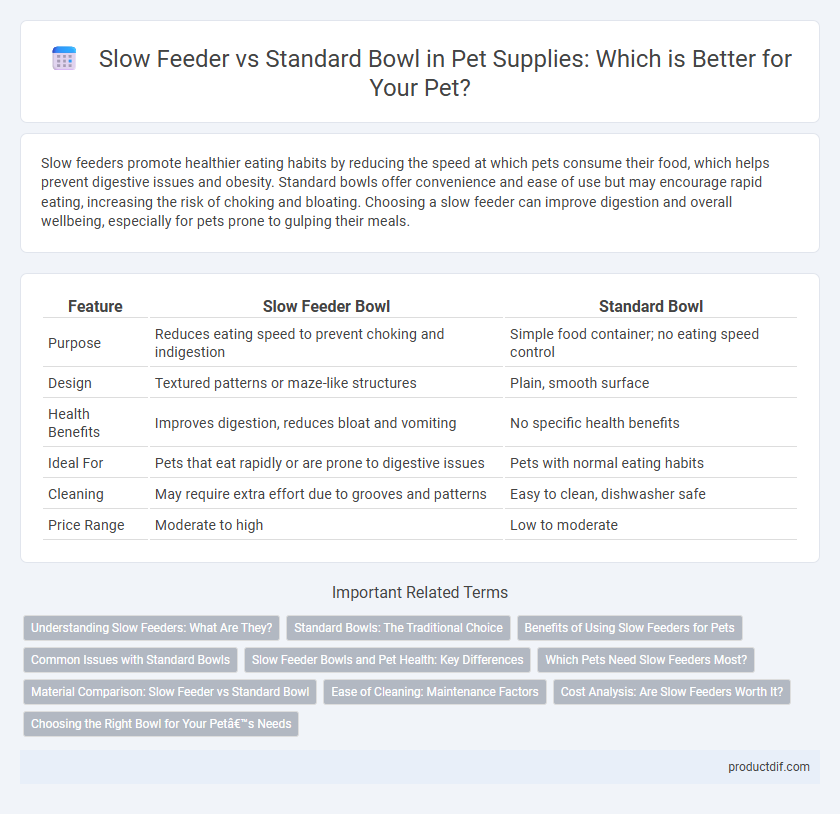Slow feeders promote healthier eating habits by reducing the speed at which pets consume their food, which helps prevent digestive issues and obesity. Standard bowls offer convenience and ease of use but may encourage rapid eating, increasing the risk of choking and bloating. Choosing a slow feeder can improve digestion and overall wellbeing, especially for pets prone to gulping their meals.
Table of Comparison
| Feature | Slow Feeder Bowl | Standard Bowl |
|---|---|---|
| Purpose | Reduces eating speed to prevent choking and indigestion | Simple food container; no eating speed control |
| Design | Textured patterns or maze-like structures | Plain, smooth surface |
| Health Benefits | Improves digestion, reduces bloat and vomiting | No specific health benefits |
| Ideal For | Pets that eat rapidly or are prone to digestive issues | Pets with normal eating habits |
| Cleaning | May require extra effort due to grooves and patterns | Easy to clean, dishwasher safe |
| Price Range | Moderate to high | Low to moderate |
Understanding Slow Feeders: What Are They?
Slow feeders are specially designed pet bowls that feature obstacles or ridges to slow down a pet's eating pace, reducing the risk of choking, bloating, and indigestion. Unlike standard bowls, which provide an open, smooth surface for quick consumption, slow feeders encourage pets to eat more mindfully and promote better digestion. These bowls are particularly beneficial for dogs and cats prone to overeating or rapid eating behaviors.
Standard Bowls: The Traditional Choice
Standard bowls remain the traditional choice for pet feeding due to their simplicity and ease of cleaning. They come in various materials such as stainless steel, ceramic, and plastic, offering affordable options for pet owners. Standard bowls are ideal for pets without eating speed issues, ensuring an accessible and straightforward mealtime experience.
Benefits of Using Slow Feeders for Pets
Slow feeders promote healthier eating habits by reducing the speed at which pets consume food, minimizing risks of choking, bloating, and digestive issues. These innovative bowls encourage mental stimulation and prevent overeating, supporting weight management and overall well-being. Pets using slow feeders often experience improved digestion and less food-related anxiety compared to standard bowls.
Common Issues with Standard Bowls
Standard bowls often lead to rapid eating, increasing the risk of choking, vomiting, and digestive issues like bloating in pets. The lack of obstruction in regular bowls encourages gulping, which can cause discomfort and reduce nutrient absorption. Slow feeders mitigate these risks by promoting slower, more controlled eating habits, improving overall pet health.
Slow Feeder Bowls and Pet Health: Key Differences
Slow feeder bowls promote healthier eating habits by slowing down a pet's food intake, reducing the risk of bloating, choking, and obesity. These bowls feature maze-like designs that engage pets mentally and physically, encouraging portion control. Standard bowls lack these features, often leading to rapid eating and associated digestive issues in pets.
Which Pets Need Slow Feeders Most?
Slow feeders are essential for pets prone to gulping food rapidly, such as Bulldogs, Pugs, and other brachycephalic breeds that risk choking or indigestion. Dogs with obesity or digestive issues benefit significantly from slow feeders as they promote gradual eating, reducing bloating and improving nutrient absorption. High-energy or anxious pets that consume meals too quickly also require slow feeders to encourage mindful eating and prevent gastrointestinal problems.
Material Comparison: Slow Feeder vs Standard Bowl
Slow feeder bowls are commonly made from durable, non-toxic materials such as BPA-free plastic, stainless steel, and silicone, designed to withstand persistent chewing and resist bacteria buildup. Standard bowls are typically made from ceramic, stainless steel, or plastic, with stainless steel being highly durable and easy to sanitize but ceramic offering weight stability to prevent tipping. Silicone slow feeders provide flexibility and ease of cleaning, while ceramic standard bowls prioritize aesthetic appeal and stability but may chip or crack over time.
Ease of Cleaning: Maintenance Factors
Slow feeder bowls often feature intricate designs and ridges that can trap food particles, making cleaning more time-consuming compared to standard bowls. Standard bowls typically have smooth surfaces that allow for quick and efficient washing, reducing maintenance efforts. Choosing a bowl with dishwasher-safe materials further enhances ease of cleaning for both slow feeders and standard bowls.
Cost Analysis: Are Slow Feeders Worth It?
Slow feeders typically cost between $10 and $30, while standard bowls range from $5 to $15, reflecting a moderate price difference. Investing in a slow feeder can reduce health issues caused by rapid eating, potentially lowering veterinary bills associated with bloating and obesity. Evaluating the long-term health benefits against the initial cost shows that slow feeders often provide better value through improved pet wellness and reduced medical expenses.
Choosing the Right Bowl for Your Pet’s Needs
Choosing between a slow feeder and a standard bowl depends on your pet's eating habits and health needs. Slow feeders are designed with ridges or obstacles to slow down fast eaters, reducing risks of choking, bloating, and obesity, beneficial for breeds prone to gulping food. Standard bowls offer simplicity and ease of cleaning but may contribute to overeating in pets that eat too quickly, making slow feeders a better choice for promoting mindful eating and digestion.
Slow Feeder vs Standard Bowl Infographic

 productdif.com
productdif.com